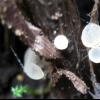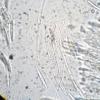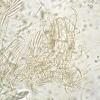
04-01-2026 17:45
 Stephen Martin Mifsud
Stephen Martin Mifsud
I was happy to find these orange asmocyetes which

03-01-2026 13:08
Niek SchrierHi all,We found groups of perithecia on a Lecanora

29-12-2025 17:44
Isabelle CharissouBonjour,J'aimerais savoir si d'autres personnes au

02-01-2026 17:43
MARICEL PATINOHi there, although I couldn't see the fruitbody, I

01-01-2026 18:35
Original loamy soil aside a artificial lake.The co

31-12-2025 19:27
Collected from loamy soil, at waterside (completel
Gelatinous on Carex
Marja Pennanen,
02-09-2010 10:38
I found these on some Carex yesterday.
They are 1-5mm wide and 3-5 mm high.
Marja Pennanen,
02-09-2010 10:43
Marja Pennanen,
02-09-2010 11:35
Hans-Otto Baral,
02-09-2010 12:13

Re:Gelatinous on Carex
Good find!!
The top cell contains a VB, i.e. a refractive vacuole (like in Mollisia). If you add KOH or MLZ these VBs disappear, also in the herbarium.
This species is Ombrophila pileata (= Hymenoscyphus pileatus). Gel and apical ring tpye clearly exclude Hymenoscyphus, still the current name in IF (although I corrected to Ombrophila already in 1985). The problem is only that in Karsten's type material which I studied is a mixtum: it contains also a very similar species with distinctly smaller and narrower and rather strongly curved spores, O. lacustris. regrettably, Karsten's is not clear in this point, giving +/- both spore types. So I have to select one of them as lectotype.
Zotto
The top cell contains a VB, i.e. a refractive vacuole (like in Mollisia). If you add KOH or MLZ these VBs disappear, also in the herbarium.
This species is Ombrophila pileata (= Hymenoscyphus pileatus). Gel and apical ring tpye clearly exclude Hymenoscyphus, still the current name in IF (although I corrected to Ombrophila already in 1985). The problem is only that in Karsten's type material which I studied is a mixtum: it contains also a very similar species with distinctly smaller and narrower and rather strongly curved spores, O. lacustris. regrettably, Karsten's is not clear in this point, giving +/- both spore types. So I have to select one of them as lectotype.
Zotto
Marja Pennanen,
02-09-2010 12:23
Re:Gelatinous on Carex
Thank you for det. and explanations :)
Marja
Marja





